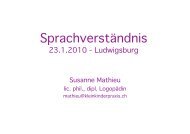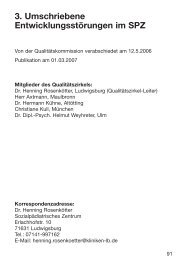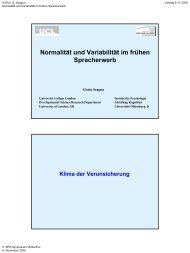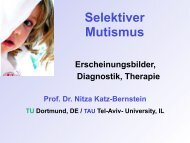(Central) Auditory Processing Disorders - Technical Report
(Central) Auditory Processing Disorders - Technical Report
(Central) Auditory Processing Disorders - Technical Report
- No tags were found...
Create successful ePaper yourself
Turn your PDF publications into a flip-book with our unique Google optimized e-Paper software.
2 / 2005<br />
American Speech-Language-Hearing Association<br />
versy regarding the use of the new term, particularly<br />
as most definitions of the disorder focus on the central<br />
auditory nervous system (CANS). Therefore, the<br />
members of the group agreed to use the term (central)<br />
auditory processing disorder [(C)APD] for the purpose<br />
of this report, with the understanding that the terms<br />
APD and (C)APD are to be considered synonymous.<br />
Definition of (C)APD<br />
Broadly stated, (<strong>Central</strong>) <strong>Auditory</strong> <strong>Processing</strong><br />
[(C)AP] refers to the efficiency and effectiveness by<br />
which the central nervous system (CNS) utilizes auditory<br />
information. Narrowly defined, (C)AP refers<br />
to the perceptual processing of auditory information<br />
in the CNS and the neurobiologic activity that underlies<br />
that processing and gives rise to electrophysiologic<br />
auditory potentials. (C)AP includes the<br />
auditory mechanisms that underlie the following<br />
abilities or skills: sound localization and lateralization;<br />
auditory discrimination; auditory pattern recognition;<br />
temporal aspects of audition, including<br />
temporal integration, temporal discrimination (e.g.,<br />
temporal gap detection), temporal ordering, and temporal<br />
masking; auditory performance in competing<br />
acoustic signals (including dichotic listening); and<br />
auditory performance with degraded acoustic signals<br />
(ASHA, 1996; Bellis, 2003; Chermak & Musiek, 1997).<br />
(<strong>Central</strong>) <strong>Auditory</strong> <strong>Processing</strong> Disorder [(C)APD]<br />
refers to difficulties in the perceptual processing of<br />
auditory information in the CNS as demonstrated by<br />
poor performance in one or more of the above skills.<br />
Although abilities such as phonological awareness,<br />
attention to and memory for auditory information,<br />
auditory synthesis, comprehension and interpretation<br />
of auditorily presented information, and similar<br />
skills may be reliant on or associated with intact central<br />
auditory function, they are considered higher<br />
order cognitive-communicative and/or languagerelated<br />
functions and, thus, are not included in the<br />
definition of (C)AP. Definitions of other key terms<br />
used in this report can be found in the Appendix.<br />
Nature of (C)APD<br />
(C)APD is a deficit in neural processing of auditory<br />
stimuli that is not due to higher order language,<br />
cognitive, or related factors. However, (C)APD may<br />
lead to or be associated with difficulties in higher<br />
order language, learning, and communication functions.<br />
Although (C)APD may coexist with other disorders<br />
(e.g., attention deficit hyperactivity disorder<br />
[ADHD], language impairment, and learning disability),<br />
it is not the result of these other disorders. For<br />
example, children with autism or ADHD often<br />
present with listening and/or spoken language comprehension<br />
difficulties; however, these difficulties are<br />
not due to a deficit in the CANS per se, but rather to<br />
their higher order, more global disorder. Thus, it<br />
would not be appropriate to apply the diagnostic label<br />
of (C)APD to the listening difficulties exhibited by<br />
these children unless a comorbid deficit in the CANS<br />
can be demonstrated.<br />
One particular area of debate has concerned the<br />
modality-specific nature of (C)APD and its differential<br />
diagnosis. Some definitions of (C)APD imply (or<br />
state outright) that the diagnosis of (C)APD can be<br />
applied only when a (perceptual) deficit is demonstrated<br />
in the auditory system and nowhere else (e.g.,<br />
Cacace & McFarland, 1998; Jerger & Musiek, 2000;<br />
McFarland & Cacace, 1995). At its extreme, this would<br />
mean that individuals with auditory temporal processing<br />
deficits who also display pansensory temporal<br />
deficits (e.g., Tallal, Miller, & Fitch, 1993) would,<br />
therefore, not meet diagnostic criteria for (C)APD. An<br />
extensive literature in neuroscience influenced the<br />
Working Group’s conclusion that the requirement of<br />
“modality-specificity” as a diagnostic criterion for<br />
(C)APD is not consistent with how processing actually<br />
occurs in the CNS. Basic cognitive neuroscience<br />
has shown that there are few, if any, entirely compartmentalized<br />
areas in the brain that are solely responsible<br />
for a single sensory modality (Poremba et al.,<br />
2003; Salvi et al., 2002). Instead, multimodality influences<br />
inform even the most basic neural encoding and<br />
manipulation of sensory stimuli (e.g., Calvert et al.,<br />
1997; Mottonen, Schurmann, & Sams, 2004; Sams et<br />
al., 1991). Evidence of convergent sensory “tracks,”<br />
multisensory neurons, and neural interfacing further<br />
demonstrates the interdependent and integrated processing<br />
of sensory data, supported by cognitive domains<br />
(i.e., attention, memory) and language<br />
representations (e.g., Bashford, Reinger, & Warren,<br />
1992; Bradlow & Pisoni, 1999; Groenen, 1997; Phillips,<br />
1995; Salasoo & Pisoni, 1985). In fact, a rigorous assessment<br />
of multimodality function is not within the<br />
scope of practice of any one professional group or<br />
discipline. Therefore, based on an extensive review<br />
of the literature in auditory and cognitive neuroscience,<br />
neuropsychology, and related areas, this<br />
Working Group concluded that any definition of<br />
(C)APD that specifies complete modality-specificity<br />
as a diagnostic criterion is neurophysiologically untenable.<br />
Instead, our definition and conceptualization<br />
of (C)APD must be consistent with the manner in<br />
which auditory and related processing occurs in the<br />
CNS. Nevertheless, it is recognized that individuals<br />
with (C)APD exhibit sensory processing deficits that<br />
are more pronounced in the auditory modality and,<br />
in some individuals, auditory-modality-specific effects<br />
may be demonstrated (Cacace & McFarland,<br />
1998).







